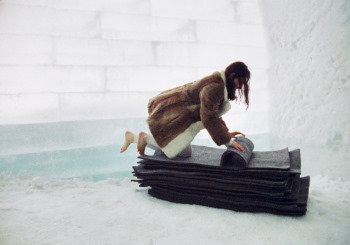True North
dal 1/2/2008 al 12/4/2008
Segnalato da
1/2/2008
True North
Deutsche Guggenheim, Berlin
The exhibition features the work of seven contemporary artists whose photographic or video-based projects evoke the tradition of Northern Romantic landscape painting as well as its legacy in later nineteenth-century photography. Yet unlike their Romantic antecedents, the works in this exhibition are historically and politically self-reflexive and call into question the notion of a pure, unchangeable North. Melancholic in tone, many of these projections point instead to a certain loss of purity; they connect supposedly untouched northern landscapes to protagonists who attempt to inhabit, colonize, or commune with the harsh nature of the North.

curated by Jennifer Blessing
True North features the work of seven contemporary artists whose photographic or video-based projects evoke the tradition of Northern Romantic landscape painting as well as its legacy in later nineteenth-century photography. Yet unlike their Romantic antecedents, the works in this exhibition are historically and politically self-reflexive and call into question the notion of a pure, unchangeable North. Melancholic in tone, many of these photographs and video projections point instead to a certain loss of purity; they connect supposedly untouched northern landscapes to protagonists who attempt to inhabit, colonize, or commune with the harsh nature of the North.
Drawn largely from the permanent collection of the Solomon R. Guggenheim Museum, True North focuses on elegiac imagery by a group of international artists who have lived in or produced work about various northern locations, including the landscapes of Canada, Iceland, and the Netherlands.
Whether present or strangely absent, the motif of the horizon recurs in much of the work included in True North. In Roni Horn’s large-scale installation Pi (1997–98), a circular horizon of photographs depicts various cycles that take place in and around Iceland: a couple and their habitual viewing of the daytime soap opera Guiding Light, the life cycle of eider ducks, and the tidal conditions of the surrounding sea. Olafur Eliasson’s The glacier series (1999) presents a serial grid of 42 images of vast glaciers, documented from a prop plane. Denying its Romantic connotations, the horizon is pushed to the edges of each frame. In Elger Esser’s Ameland-Pier X (2000), however, the horizon line remains one of the only visible features of a dematerialized white landscape.
Other works, such as Orit Raff’s video Palindrome (2001) and Thomas Flechtner’s Glaspass (Walks #10) (2001) detail the difficult futility of communing with a North that tests the limits of human influence and survival. Raff’s female protagonist obsessively stacks felt in an attempt to create warmth—a futile gesture made all the more enigmatic by the juxtaposition of footage of a coyote comfortably navigating a frigid landscape. Often working in remote regions, Flechtner also questions the viability of humanity’s presence in the frozen North. In Glaspass (Walks #10) he photographs his own ski tracks, which trace the topography of a barren snow-field. The skiers pictured in Armin Linke’s Ski Dome, Tokyo, Japan (1998) on the other hand, enjoy an artificial North constructed within a now-demolished ski slope in the suburbs of Tokyo.
True North also touches on the North’s function as a site of political antagonism and historical repression. In his video installation Nu•tka• (1996), Stan Douglas uncovers conflict in the wilderness of western Canada by pairing various spoken texts, which include eighteenth-century narratives of colonization, with two staggered, opposing films of this remote region. Foregrounding the North as a site of traumatic loss, Douglas presents a landscape seemingly shattered by human strife.
A place that most can only experience from a distance via various modes of mediation, the North as an idea presents an opportunity to examine the connection between reality and representation. Many of the works in True North probe this relationship, picturing a North that mutates, erases, or overwhelms.
Image: Orit Raff, Palindrome (film still), 2001. Courtesy des Künstlers und Julie Saul Gallery
Deutsche Guggenheim
Unter den Linden 13/15 - Berlin
Opening hours: Daily 10 a.m. to 8 p.m. Thursdays to 10 p.m.
Admission: Adults euro 4; reduced euro 3; Children under 12: Admission free; School classes: Admission free



